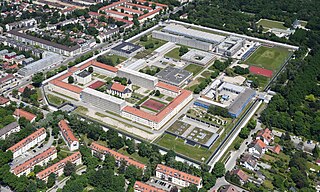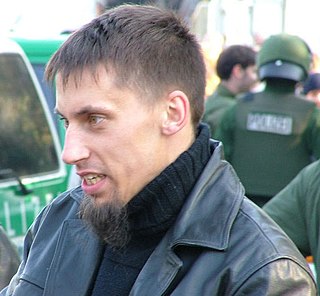
The Turner Diaries is a 1978 fiction novel by William Luther Pierce, a neo-Nazi and the founder and chairman of National Alliance, a white nationalist group, published under the pseudonym Andrew Macdonald. It depicts a violent revolution in the United States which leads to the overthrow of the federal government, a nuclear war, and ultimately a race war which leads to the systematic extermination of non-whites and Jews. All groups opposed by the novel's protagonist, Earl Turner—including Jews, non-white people, "liberal actors," and politicians—are murdered en masse.

Stadelheim Prison, in Munich's Giesing district, is one of the largest prisons in Germany.

The Solingen arson attack was one of the most severe instances of xenophobic violence in modern Germany. On the night of 28–29 May 1993, four young German men belonging to the far right skinhead scene, with neo-Nazi ties, set fire to the house of a large Turkish family in Solingen in North Rhine-Westphalia, Germany. Three girls and two women died; fourteen other family members, including several children, were injured, some of them severely. The attack led to violent protests by Turkish diaspora members in several German cities and to large demonstrations of other Germans expressing solidarity with the Turkish victims. In October 1995, the perpetrators were convicted of arson and murder and given prison sentences between 10 and 15 years. The convictions were upheld on appeal.
Uwe Böhnhardt was a German right-wing extremist who was one of three core members of National Socialist Underground (NSU), a neo-Nazi terror group that included scores of associates providing logistical support to the core trio. The other two core members were Uwe Mundlos and Beate Zschäpe. It is believed that Böhnhardt was killed in 2011 by Mundlos in an apparent murder-suicide.

Uwe Mundlos was a German neo-Nazi, right-wing terrorist and serial killer. Together with Uwe Böhnhardt and Beate Zschäpe, he formed the nucleus of the terrorist group National Socialist Underground (NSU), which was responsible for 10 murders, 43 attempted murders, 3 explosive attacks, and 15 bank robberies in Germany between 1998 and 2011. He died after a bank robbery led to his discovery by police, presumably by suicide.

Beate Zschäpe is a German far-right extremist and a member of the National Socialist Underground (NSU), a neo-Nazi terrorist organization. In July 2018, she was sentenced to life imprisonment for numerous crimes committed in connection with the NSU, including murder and arson.

On 9 June 2004, a nail bomb detonated in Cologne, Germany, in a business area popular with immigrants from Turkey. Twenty-two people were wounded, with four sustaining serious injuries. A barber shop was destroyed; many shops and numerous parked cars were seriously damaged by the explosion and by the nails added to the bomb for extra damage. Authorities initially excluded the possibility of a terrorist attack. The bomb, which contained more than 800 nails, was hidden in a travel compartment on a bicycle left in front of the barber shop.

The National Socialist Underground, or NSU, was a far-right German neo-Nazi terrorist group which was uncovered in November 2011. The NSU is mostly associated with Uwe Mundlos, Uwe Böhnhardt and Beate Zschäpe, who lived together under false identities. Between 100 and 150 further associates were identified who supported the core trio in their decade-long underground life and provided them with money, false identities and weapons. Unlike other terror groups, the NSU had not claimed responsibility for their actions. The group's existence was discovered only after the deaths of Böhnhardt and Mundlos, and the subsequent arrest of Zschäpe.

The NSU trial or National Socialist Underground trial was a trial in Germany against several people in connection with the National Socialist Underground (NSU) – an extreme-right terrorist organization – and the NSU murders. It took place between 6 May 2013 and 11 July 2018 in Munich before the Munich Higher Regional Court. The trial was notable for being one of the largest, longest and most expensive in German history and made public claims of institutionalized racism within the German police force who for years ruled out Neo-Nazis as potential suspects in the killings and instead focused on suspects with Turkish backgrounds," going so far as to name their investigation "Bosporus."

The Memorial and Information Point for the Victims of National Socialist Euthanasia Killings is a memorial in Berlin, Germany to the victims of Nazi Germany's state-sponsored involuntarily euthanasia program. Over 70,000 people were murdered between 1940–41 under official order of Aktion T4. Despite the program's technical cessation in August 1941, the killings continued in state-run institutions and care facilities until Germany's surrender in 1945. This amounted to a death toll of approximately 300,000.

Michèle Kiesewetter, a German police officer, was killed by neo-Nazi terrorists. On the 25 April 2007, Michèle Kiesewetter and her partner were on patrol in their police car. At approximately 2:00p.m., they stopped in a corner of a large parking lot in Heilbronn to have a lunch break. Shortly after, both officers were ambushed and shot in the head by two gunmen, approaching from behind the vehicle. Michèle Kiesewetter, sitting in the driver's seat, was fatally injured. Her partner, sitting in the passenger's seat, was heavily injured, but survived the attack. When the police and the ambulance arrived on the scene, both officers were lying on the ground, next to their car, and their handguns and handcuffs were stolen. The gunmen have also been implicated with the murders of nine other people, most with Turkish roots, between 2000 and 2006, the so-called NSU murders.
NSU German History X is the American name for the 2016 German TV miniseries Mitten in Deutschland: NSU. The three-part series dramatizes the true events and characters of the National Socialist Underground, a neo-Nazi German terrorist group that was uncovered in November 2011.
Helmut Roewer is a German lawyer and author. He served between 1994 and 2000 as president of the regional office for protection of the constitution in Thuringia. This is a state-level security agency. Controversy in respect of his time in office has persisted, although he himself robustly rejects most of the criticisms of his decisions made at that time.

Ralf Wohlleben is a German Neo-Nazi and was a supporter of the terrorist group Nationalsozialistischer Untergrund (NSU). He was deputy state chairman and press spokesman of the Nationaldemokratischen Partei Deutschlands (NPD) in Thuringia, and chairman of the district association of the NPD Jena. He is one of the leading Neo-Nazis in the Free State of Thuringia. On 11 July 2018, he was sentenced to 10 years in prison.
PC Records is a German Neo-Nazi music label. The label is an artistic outlet for the Chemnitz Neo-Nazi scene and one of the most active of the far-right and "Rock Against Communism" music scene in Germany. PC Records is releasing some of the most regionally popular Neo-Nazi bands. Several of the albums released by the label have been indexed for Neo-Fascist content. The label includes a shop and a mailorder business. The name "PC" refers to the phrase "Political Correctness, no thanks!"

The Hanau shootings occurred on 19 February 2020, when eleven people were killed and five others wounded in a terrorist shooting spree by a far-right extremist targeting a shisha bar, a bar and a kiosk in Hanau, near Frankfurt, Hesse, Germany. After the attacks, the gunman returned to his apartment, where he killed his mother and then committed suicide. The massacre was called an act of terrorism by the German Minister of Internal Affairs.

Khubaib-Ali Mohammed is a German criminal defense lawyer with Pakistani roots.
Enver Şimşek was a Turkish-born businessman in Germany who was the first victim of the series of murders by the National Socialist Underground (NSU) terrorist group. The owner of a flower shop in Schlüchtern in Hesse, he was gunned down on 9 September 2000 at a mobile flower stand in Nuremberg. Two days later he died in a hospital as a result of injuries sustained in the attack.
Peggy Knobloch was a nine-year-old girl from Lichtenberg, Bavaria, who was kidnapped and murdered on 7 May 2001. Her body was located 15 years later in a wooded area near Wurzbach. In 2020, investigators shelved the investigation of her murder without solving it. Some newspapers refer to her as the "German Madeleine McCann".
















